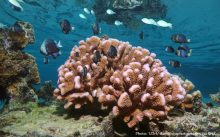
In 2016, Stephen Simpson, a marine biologist at the University of Bristol in England, returned to a study site off Australia’s Lizard Island, part of the Great Barrier Reef. Back-to-back cyclones that smashed reefs and turned corals upside down had hit in 2014 and 2015, followed by a massive bleaching event in 2016, which ravaged the coral ecosystem. After all that, “It was like swimming in a graveyard,” Simpson says.









